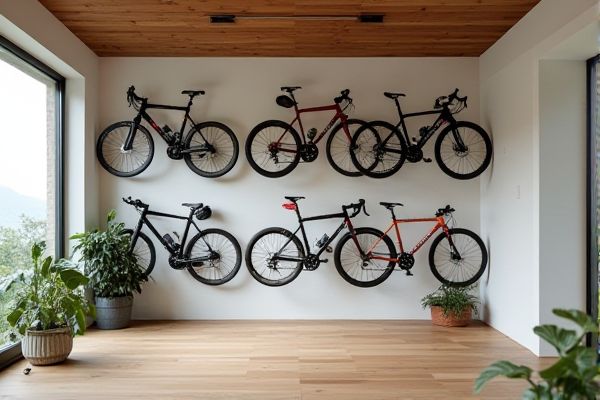
Overhead bike storage saves valuable floor space by utilizing ceiling mounts, making it ideal for compact areas, while floor bike racks offer easier access and quicker bike handling. Explore the rest of the article to determine which storage solution best fits your space and cycling needs.
Table of Comparison
| Feature | Overhead Bike Storage | Floor Bike Rack |
|---|---|---|
| Space Saving | Excellent - Uses ceiling space, frees floor area | Good - Occupies floor space, limited overlap |
| Capacity | High - Can store multiple bikes vertically | Medium - Typically stores fewer bikes side by side |
| Accessibility | Moderate - Requires lifting or pulleys | High - Easy to park and retrieve bikes |
| Installation | Complex - Needs secure ceiling mounts | Simple - Usually portable or easy to install |
| Cost | Moderate to High - Installation and hardware cost | Low to Moderate - Basic racks are affordable |
| Suitability | Ideal for garages or basements with strong ceilings | Suitable for entryways, garages, and outdoor use |
| Protection | Good - Keeps bike off floor, reduces damage risk | Variable - Risk of bike tipping or floor contact |
Introduction: Comparing Overhead Bike Storage and Floor Bike Racks
Overhead bike storage maximizes space by utilizing ceiling areas, ideal for compact living environments, while floor bike racks offer easy accessibility and stability for frequent use. Overhead systems often require durable hooks or pulleys suited for heavier bikes, whereas floor racks vary from simple stands to multi-bike organizers tailored for garages or entryways. Choosing between these depends on available space, bike size, and usage frequency to optimize storage efficiency and bike protection.
Space Efficiency: Maximizing Room with Each Storage Type
Overhead bike storage maximizes vertical space by suspending bikes from the ceiling, freeing up floor area and making it ideal for small or crowded rooms. Floor bike racks offer easy access and stable parking but consume valuable floor space, which may limit movement and reduce usable room in compact areas. Choosing overhead storage significantly improves overall space efficiency by utilizing unused overhead areas, whereas floor racks prioritize convenience at the expense of floor footprint.
Installation Requirements: Ease and Tools Needed
Overhead bike storage requires secure ceiling anchors and typically involves drills, stud finders, and heavy-duty hooks, making installation more complex and time-consuming. Floor bike racks offer straightforward setup, often requiring no tools or only minimal assembly, making them ideal for quick, hassle-free installation. The choice depends on available space and the user's comfort level with power tools and wall/ceiling mounting.
Accessibility: Retrieving and Storing Your Bike
Overhead bike storage requires lifting your bike above head height, which can be challenging for frequent use or for heavier bikes, while floor bike racks offer immediate accessibility by keeping your bike at ground level. Retrieving and storing your bike on a floor rack is quicker and more convenient, especially if you often need to grab your bike in a hurry. Your choice between overhead and floor storage should align with your physical ease and how frequently you use your bike.
Safety and Stability: Protecting Your Bike and Household
Overhead bike storage keeps your bike securely off the ground, reducing the risk of accidental bumps or falls that can damage both the bike and your household items. Floor bike racks provide stable support by holding the bike upright, minimizing the chances of tipping, especially in high-traffic areas. You should consider the layout of your space and ease of access to ensure maximum safety and stability for your bike and home environment.
Cost Considerations: Budgeting for Bike Storage
Overhead bike storage typically requires a higher initial investment due to installation complexity and hardware costs, while floor bike racks offer a more budget-friendly option with minimal setup expenses. Maintenance and durability should also be factored into the overall cost, as overhead systems often have longer lifespans and save floor space, potentially increasing property value. Evaluating these cost considerations against available space and usage frequency helps optimize budgeting for efficient bike storage solutions.
Versatility: Suitability for Different Bike Types
Overhead bike storage systems excel in versatility by accommodating various bike types, including road, mountain, and e-bikes, through adjustable hooks and ample clearance. Floor bike racks offer stability for multiple bike styles but may require specific rack shapes to securely hold different wheel sizes and frame designs. Choosing between the two depends on space constraints and the need to store a diverse range of bicycles efficiently.
Aesthetic Impact: How Each Storage Option Looks
Overhead bike storage offers a sleek, minimalist appearance by keeping bikes suspended and out of sight, maximizing floor space and contributing to a tidy environment. Floor bike racks create a more accessible, organized display but can appear bulkier and occupy visible floor area, potentially disrupting room aesthetics. Selecting between the two depends on the desired balance between visual openness and easy bike access.
Maintenance and Durability: Longevity of Storage Solutions
Overhead bike storage systems are typically constructed from heavy-duty steel or aluminum, offering excellent durability and resistance to wear, which reduces maintenance needs and extends longevity. Floor bike racks, often made from steel or reinforced plastic, require less installation effort but may be more susceptible to corrosion or damage over time, necessitating periodic upkeep. Choosing overhead storage can provide a longer-lasting solution for high-capacity use, while floor racks offer easier maintenance but potentially shorter lifespan depending on environmental exposure.
Ideal Settings: Choosing the Right Option for Your Space
Overhead bike storage is ideal for small apartments or garages with limited floor space, maximizing vertical areas without clutter. Floor bike racks work best in larger entryways or bike rooms where easy access and frequent use are priorities. Selecting between the two depends on spatial constraints and the frequency of bike usage to optimize convenience and storage efficiency.
 homyna.com
homyna.com